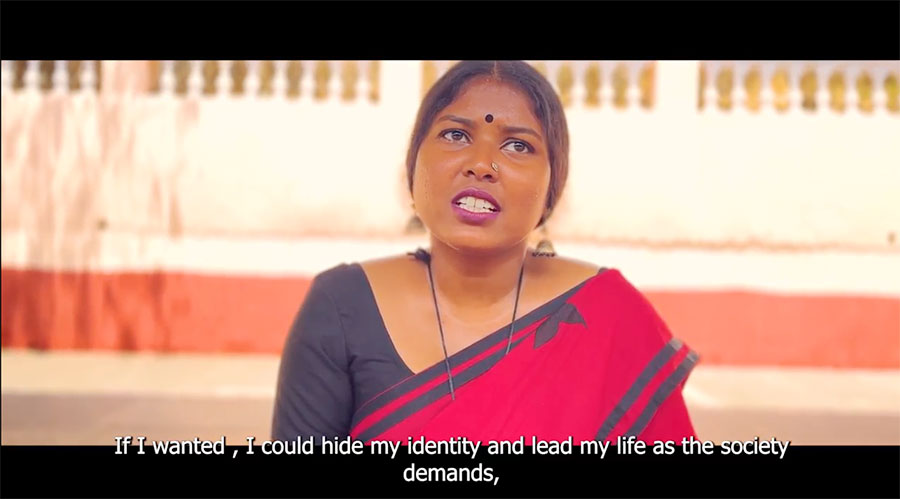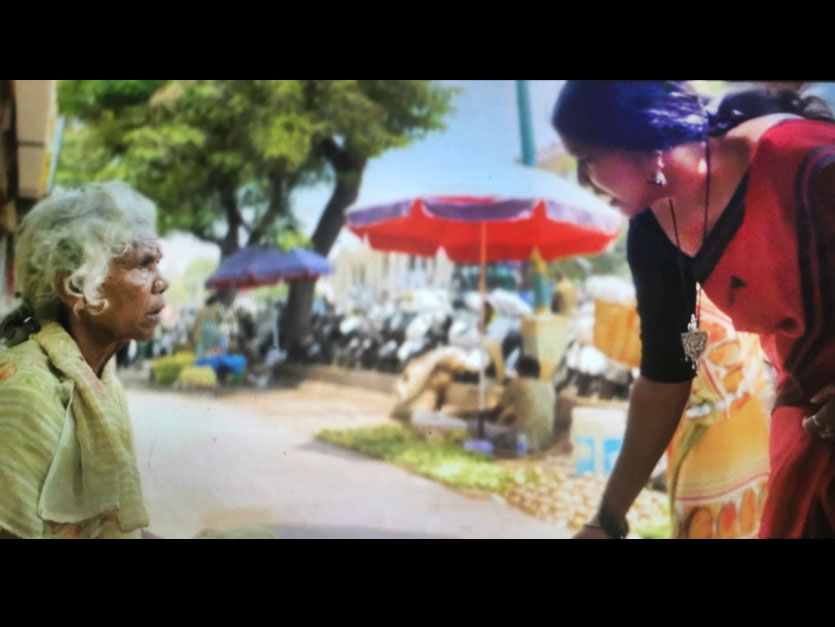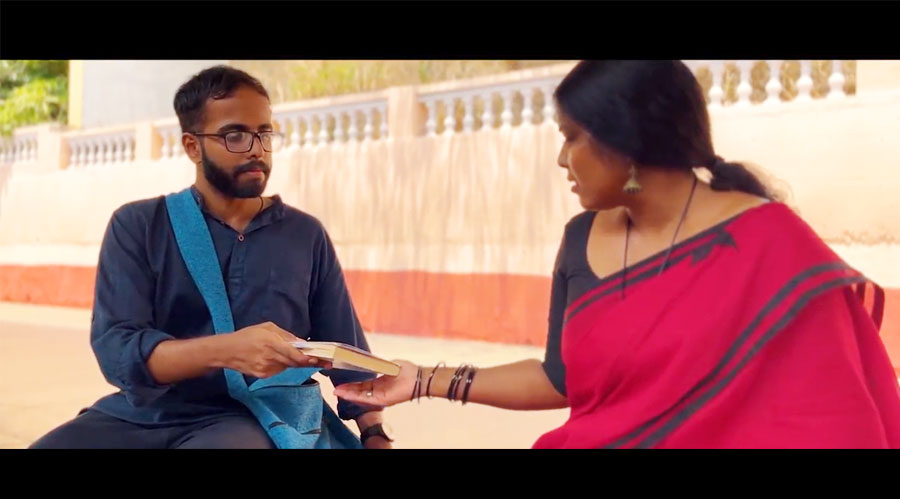
Fabienne Le Houérou
Digital Revolution in Filmmaking
in India and the Democratic Challenge
Abstract
This paper examines the profound discontinuities introduced into Indian cinema by the digital revolution, focusing on how new technologies—particularly smartphones and AI—have democratized filmmaking. It explores how these changes have enabled new representations of gender inequalities, abuse, and corruption, both in mainstream and student cinema. The analysis is grounded in films presented at the Talking Films Online (TFO) Smartphone Short Film Competition (June 2024), where emerging filmmakers, especially women, use digital tools to challenge traditional narratives and express new societal aspirations. The argument situates these transformations within the broader context of Indian democracy, which provides the space for such critical engagement and innovation.
The digital revolution has fundamentally transformed the landscape of Indian filmmaking. Affordable smartphones, AI-driven tools, and widespread internet access have democratized the means of production, allowing voices previously excluded from the cinematic mainstream to participate in shaping cultural narratives. This democratization is not only technical or economic but also deeply political, enabling new forms of expression and contestation within Indian society. The Talking Films Online network (TFO), with its weekly seminars, international festivals, and filmmaking competitions, embodies this multidirectional and rhizomatic approach to cinema. Inspired by Deleuze’s concept of the rhizome, TFO fosters a horizontal, interconnected space for cinematic creation and discussion, proving particularly fertile for the emergence of new voices and perspectives, as evidenced by the films showcased at the TFO Smartphone Film Competition in June 2024.
The Digital Turn: A Democratic Revolution
The advent of affordable smartphones and widespread cellular data in India during the 2010s marked a turning point in both communication and artistic creation. The expansion of internet access enabled a new generation of filmmakers to bypass traditional gatekeepers, reducing the cost and complexity of film production. With the introduction of AI tools in 2023, tasks such as music composition, color grading, and animation became accessible to all, further lowering barriers to entry. This technological shift has had profound democratic implications, allowing young artists—especially those from marginalized backgrounds, including women—to tell their stories and challenge dominant narratives. The TFO festival, which showcased the award-winning films in the Smartphone short filmmaking competition conducted earlier, exemplifies this change: among the five award-winning films, Hafeefa Jebi’s Baala stands out as an innovative work by a young female director, emblematic of the new generation, it’s desire for freedom, self-respect, and gender equality.
Discontinuities in Representation: Gender, Abuse, and Corruption
A clear discontinuity is emerging in the representation of social issues within Indian cinema. Historically, mainstream Bollywood has avoided direct engagement with topics such as sexual violence, family abuse, and corruption. Today, both commercial and student films are confronting these issues head-on.
Gender and the New Imagination
Student films from the TFO festival in 2024 do not simply imitate commercial successes; they interrogate societal norms and highlight injustices. Themes such as gender equality, sexual autonomy, family violence, and economic disparity reflect a critical engagement with Indian society. These films reject the culture of silence surrounding abuse and discrimination, advocating instead for openness and justice. For example, Baala by Hafeefa Jebi uses digital cinema to question traditional gender roles and advocate for women’s agency. The film’s innovative approach and the director’s identity as the only female winner underscore the significance of digital democratization in amplifying marginalized voices and the female gaze.
Mainstream Cinema and Societal Critique
This trend is mirrored in commercial cinema, where a new generation of directors and actors is redefining the Indian protagonist. The era of the invincible, hyper-masculine Bollywood hero is giving way to more nuanced, realistic portrayals. Actors like Nawazuddin Siddiqui embody this shift, representing ordinary individuals rather than idealized figures. Films such as Delhi Crime (Netflix, 2019) and Mom (2017) have tackled subjects like rape and the failures of the legal system. Delhi Crime dramatizes the investigation of the 2012 Nirbhaya case, confronting the realities of sexual violence in India. Mom tells the story of a mother seeking justice for her assaulted daughter, highlighting both the resilience of women and the inadequacies of institutional responses. Corruption, another persistent theme, is explored in Sacred Games (Netflix, 2018), which delves into Mumbai’s criminal underworld and the complicity of political institutions. These films, along with student works from TFO, illustrate how digital and democratic transformations are reshaping the thematic landscape of Indian cinema.
Democracy as Driving Force
Crucially, these discontinuities are not occurring in a vacuum. India’s democratic framework—imperfect but vibrant—provides the space for such critical engagement. Freedom of expression, though contested, allows filmmakers to challenge social hierarchies and question abuses of power. The digital revolution amplifies this potential, making it possible for previously unheard voices to participate in public debate. The impact of democracy is visible not only in the content of these films but in their very production and distribution. Digital platforms and festivals like TFO create horizontal networks of exchange, bypassing traditional gatekeepers and fostering a rhizomatic, Deleuzian model of cultural production. This democratization is both a cause and a consequence of the new critical cinema.
Case Studies: Integrating Film Examples
Discontinuities in representation are evident in both student and commercial films:
- Rape and Gender Violence: Delhi Crime (Netflix, 2019) dramatizes the investigation of the 2012 Delhi gang rape, bringing to light the complexities of policing, justice, and societal attitudes toward gender violence.
- Women’s Agency: Mom (2017), starring Sridevi, tells the story of a mother seeking justice for her stepdaughter, highlighting the failures of the legal system and the resilience of women.
- Corruption: Sacred Games (Netflix, 2018) explores Mumbai’s criminal underworld and the complicity of political institutions.
- Student Films: Works like Baala and Echoes of Freedom (TFO, 2024) address themes of gender equality, abuse, and the right to self-expression, demonstrating the critical engagement of the younger generation.
Towards a New Cinematic Public Sphere
The digital revolution has enabled significant discontinuities in Indian cinema, particularly in the representation of gender inequalities, abuse, and corruption. These changes are inseparable from India’s democratic context, which, despite its challenges, provides the conditions for critical engagement and social transformation. By weaving together commercial and student filmmaking, and by integrating the question of democracy throughout the analysis, we can better understand the profound shifts underway in Indian visual culture. The new cinematic landscape is more diverse, critical, and socially engaged- a reflection of the dynamism and openness of Indian democracy, and a harbinger of further change to come.
Discontinuities as Shown in Student Films (2024)
The commercial successes of recent series and movies have encouraged directors and producers to experiment with new subjects, particularly social themes. Same-sex love, for example, is often suggested in thrillers representing gay or transgender relationships, depicted without judgment or societal morality. This absence of moral judgment and the pursuit of understanding and tolerance is evident in the student competition films of 2024. The short film Baala, directed by Hafeefa Jebi, particularly illustrates this desire for comprehension of marginalized and minority sexualities, approaching the transgender experience with narrative intelligence and decency.
Key Themes in Student Films
- Family Conflicts and Abuses: Appa (2024) explores a father-son conflict, depicting family violence—a subject rarely addressed in traditional Indian cinema.
- Patriarchy and Gender Equality: Kaifot (2024) portrays a female student’s struggle with economic precarity and highlights patriarchal oppression, even from other women.
- Self-Love and Gender Abuse: Naari Nehi (2024) addresses self-love and gender abuse with efficiency and clarity.
- Sorority and Solidarity: The Break (2024) examines female socialization and collective solidarity among students.
- Rape and Family Violence: The Fairy (2024) confronts the issue of rape directly, depicting intra-familial violence and challenging the narrative of the outsider rapist.
- Social Hypocrisy: Hypocrite (2024) interrogates societal hypocrisy.
- Bullying and Intimacy: Manzar (2024) explores bullying and the challenges of female intimacy, particularly regarding nudity.
- Rage and Freedom: Echoes of Freedom (2024) uses metaphor to express rage and frustration, earning special mention at the TFO festival.
- Addiction and Social Pressure: Ragged (2024) narrates the challenges faced by youth regarding addiction, harassment, and the transformation from “good” to “bad”.
These films collectively express the unease of student life, economic precarity, social harassment, and the aspiration for equality and happiness in an often unsympathetic environment. They share a critical perspective on student reality and articulate a desire for fairness and gender equality. Underlying these expressions is a thirst for dialogue, analysis, and the assertion of individual will against familial imposition.
The Quest for Self-Esteem and Individuality
A central message in these student films is the importance of the self and individuality. The desire for independence, financial autonomy, sovereignty of choice, self-love, and self-determination is omnipresent. The construct of self-esteem, as shown in films like Naari Nehi and Baala, is associated with positive outcomes such as academic achievement, relationship satisfaction, happiness, and lower rates of anti-social behaviour. These works emphasize that what matters is not society’s gaze, but the individual’s self-love and self-worth.
Technical Discontinuities Enabled by the Technological Revolution
The technical mastery displayed in the student films of June 2024 is remarkable, not only for their courageous exploration of new or taboo subjects but also for their proficient use of small cameras and smartphones. Filmmakers leveraged the capabilities of smartphones, including advanced movement and stabilization, to achieve cinematic quality. The use of gimbals—devices that stabilize camera movement—has become essential for achieving smooth, professional footage, with AI-driven features further enhancing the cinematic effect.
Case study of the student film Baala (2024)
For example, the technical aspects of this short film are handled with remarkable skill: the camera movements are fluid, and the use of lighting and metaphor is sophisticated, making it indistinguishable from films shot with traditional equipment.
In Baala, every technical element is carefully managed. The camera glides so smoothly that viewers would never suspect the film was shot on a smartphone. The railway station, where the story unfolds, serves as a powerful metaphor for the situation of the transgender girl begging for change. A poignant exchange takes place between a male student and the transgender beggar and sex worker, as they share gifts: Baala finds and returns the student’s wallet, and in return, he offers her a book titled Hidden Soul, an invitation to look beyond social conventions. Baala is not judged, but rather seen, acknowledged, appreciated, and understood as a person.
A conversation on a railway station bench is filmed in an original way: instead of using the classic shot-reverse-shot technique to depict dialogue, both actors face the camera on the same plane. This choice is significant, whether intentional or not—it conveys a profound sense of modesty, as both characters avoid direct eye contact while sharing deeply personal thoughts.
At one point, Baala says, “I will never be myself,” highlighting once again the challenging notion of what it means to “be yourself” in society.
Cinema, Free Speech, and Democracy in Students Short Films
“My voice does count” is the unifying message of these student short films. Interpreted politically, it reflects a genuine desire for democracy and poses a democratic challenge. The filmmakers’ message suggests that free speech lies at the core of these aspirations. In a society that values free speech, people can engage openly in debates on a range of issues, from politics to social concerns. Such open and varied discussions foster a more nuanced understanding of complex topics.
It hardly needs stating that free speech and expression are the lifeblood of democracy. For students, the ability to express themselves freely is crucial. Open debate enables the consideration of diverse perspective and interests, as well as the negotiation and compromise essential for reaching consensus in policy decisions. As Meiklejohn argues, suppressing nonviolent expression does not ensure peace and stability; rather, it allows underlying problems to grow unnoticed until they erupt in more dangerous ways (Meiklejohn, 2011)

Fig. 1. – Baala (2024). Film still taken from the video from the short film Baala (2024) from the Student Film Competition organized by Talking Film on Line (India).

Fig. 2 – Baala (2024). Film still taken from the video from the short film Baala (2024) from the Student Film Competition organized by Talking Film on Line (India).

Fig. 3 – Baala (2024). Film still taken from the video from the short film Baala (2024) from the Student Film Competition organized by Talking Film on Line (India).
A Pluralistic Cinematic Landscape: The Democratic Value of Diversity
The democratic transformation of Indian cinema is not confined to the rise of student or mainstream commercial films alone. Rather, it is the remarkable diversity across the entire cinematic spectrum—independent, commercial, regional, experimental, and foreign films—that truly embodies the spirit of a democratic culture.
Indie and Experimental Films
Independent and experimental filmmakers have long pushed the boundaries of narrative and form, often addressing taboo or neglected subjects with a boldness that mainstream cinema might avoid. Directors like Anurag Kashyap and Rima Das have used modest budgets and innovative storytelling to highlight rural realities, gender struggles, and social change. Experimental cinema, often showcased at festivals like the Mumbai International Film Festival (MIFF) or the Dharamshala International Film Festival, provides a platform for avant-garde filmmakers to experiment with form, technology, and narrative.
Regional Cinema
India’s regional film industries—producing cinema in Tamil, Telugu, Malayalam, Bengali, Marathi, Kannada, and other languages—are a testament to the country’s linguistic and cultural diversity. Films such as Pariyerum Perumal (Tamil), Sairat (Marathi), Jallikattu (Malayalam), and Nagarkirtan (Bengali) have achieved critical acclaim and sparked important conversations about caste, gender, class, and sexuality within their local contexts.
Commercial Cinema
While Bollywood and other commercial industries have historically favoured escapist themes, recent years have seen a notable shift. Mainstream films like Article 15, Pink, Thappad, and Chhapaak have tackled issues of caste discrimination, consent, domestic violence, and acid attacks, bringing urgent social debates into the public sphere.
Foreign Films and Global Platforms
The availability of foreign films and global streaming platforms has broadened the horizons of Indian audiences and filmmakers. Exposure to world cinema has inspired new stylistic and thematic explorations within Indian filmmaking, fostering openness, dialogue, and innovation.
Festivals and Public Participation
Film festivals play a crucial role in democratizing access to diverse cinema, providing spaces for public debate, critical engagement, and the celebration of difference. Audience awards, public Q&As, and community screenings contribute to a participatory culture where viewers are active stakeholders in the cinematic conversation.
Conclusion and Directions for Further Research
This paper has explored the transformative impact of the digital revolution on Indian filmmaking, emphasizing how affordable technologies and AI have democratized the means of cinematic production and enabled a broader spectrum of voices to participate in shaping cultural narratives. The analysis has demonstrated that these technological advances have not only facilitated greater representation of marginalized identities and critical social themes—such as gender inequality, abuse, and corruption—but have also fostered a more pluralistic and participatory cinematic landscape.
A key finding is the emergence of significant discontinuities in both the form and content of Indian cinema. Student and independent filmmakers, empowered by digital tools, are challenging traditional hierarchies and conventions, while mainstream cinema is increasingly willing to address urgent social issues. The rhizomatic, networked nature of digital platforms and festivals has further contributed to this democratization, allowing for horizontal exchanges and bypassing traditional gatekeepers.
Importantly, these shifts are inseparable from the broader context of Indian democracy, which, despite its imperfections, continues to provide the space for critical engagement, dialogue, and innovation. The diversity of Indian cinema—spanning commercial, regional, independent, experimental, and global influences—serves as both a reflection and an engine of democratic culture.
Future Research Directions
To build on these findings, further research could:
- Examine Longitudinal Impacts: Track how digital democratization continues to shape Indian cinema over the next decade, particularly as AI and new technologies evolve.
- Analyze Audience Reception: Investigate how diverse audiences interpret and engage with the new thematic and aesthetic trends emerging from digital filmmaking.
- Explore Policy and Regulation: Assess the role of policy, censorship, and platform governance in shaping the boundaries of creative freedom and representation.
- Compare Global Contexts: Situate the Indian experience within a comparative framework, analyzing similarities and differences with other national cinemas undergoing digital transformation.
- Study Economic Sustainability: Evaluate the economic models that support independent and student filmmakers in the digital era, including crowdfunding, streaming, and festival circuits.
References
Deleuze, G. and Guattari, F. 1980 Mille Plateaux, Paris, Éditions de Minuit.
Emerson, T. 1970. The system of freedom of expression, Random House, New York, 1970, 754 p.
Le Houérou, F. 2024 Tibetan Muslims, A Minority Within A Minority. From a Kashmiri Muslim Immigration to Tibet to A Tibetan Muslim Forced Migration to India, Lit Verlag, Berlin, 2024, 89 p.
Seuils d’exils, degrés de rejet : le cas d’une femme tibétaine en exil en Inde, in Seuil, Exil, dir. Jacqueline Bergeron, Carlos Lobo, Erasmus Expertise, Pessac, 2021, pp189-201.
Migration, mixité, hybridité et images : un exemple d’écriture “rhizome” avec le Film Angu, une Femme sur le Fil(m), Science and Video, 2019, N°9 -URL : https://scienceandvideo.mmsh.fr/rush-10/
“The Tibetan Ethnic Enclave in New Delhi, A Visual perspective », 2018. Sociology Mind, 8, 203-220 -Lien: https://www.scirp.org/journal/paperinformation?paperid=84639
Meiklejohn, A. 2011. Free Speech and Its Relation to Self-Government, Harper and Brothers, New York, 2011.
Moon, R. 2024. The Life and Death of Freedom of Expression, University of Toronto Press, Toronto, 2024, 358p.

Fabienne Le Houérou
Historienne, anthropologue et réalisatrice, CNRS, IREMAM, MMSH, Aix-Marseille-Université; Fellow à l'Institut convergences migrations, Aix-en-Provence, Directrice de la Revue Science and Video
- Fabienne Le Houérou#molongui-disabled-link
- Fabienne Le Houérou#molongui-disabled-link
- Fabienne Le Houérou#molongui-disabled-link
- Fabienne Le Houérou#molongui-disabled-link

